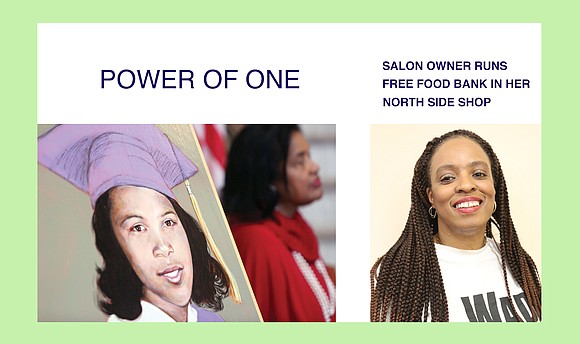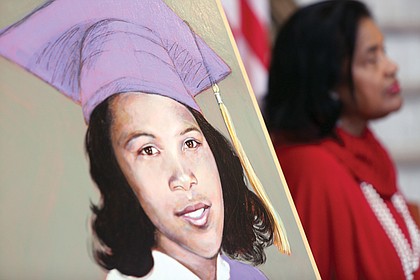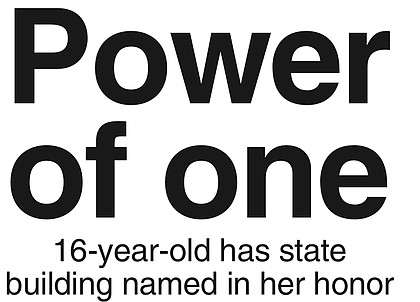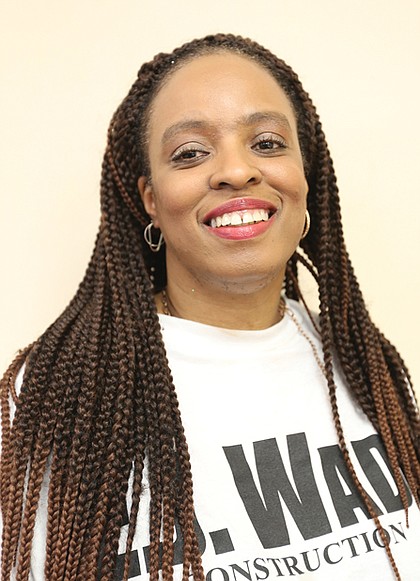Power of one / Salon owner runs free food bank in her North Side shop
16-year-old has state building named in her honor
3/3/2017, 7:04 p.m.
By Holly Rodriguez
Nearly 66 years after Barbara Johns, a 16-year-old student at Robert Russa Moton High School in Farmville, led hundreds of her classmates on a walkout to protest substandard conditions in her segregated school that were separate but not equal, her sister tearfully thanked Gov. Terry McAuliffe for naming a newly renovated state building in Downtown in Ms. Johns’ honor.
“Barbara was a strong, brave, courageous person who saw injustice and did something about it,” Joan Johns Cobbs said.
“Her legacy has been firmly planted in the statue in Capitol Square and now on this building, proving that patience is a virtue.”
Ms. Johns died in 1991 at age 56. Three of her children, Dawn, Kelly and Terry, her siblings and other relatives attended the dedication ceremony last Thursday held before an audience of more than 200 people in the ornate lobby of the building at 202 N. 9th St.
Reading from her sister’s diary, Mrs. Cobbs shared Ms. Johns’ initial discouragement when, after complaining about the school’s conditions to a teacher, she was asked, “Well, why don’t you do something about it?”
Ms. Johns wrote that she asked herself, “What could one person do about such a situation?”
After spending time in the woods praying and contemplating what to do, Ms. Johns had a vision for action that she believed was divinely inspired.
“It had been given to me and all I had to do was do it,” she wrote in her diary. That vision changed her future, and the future of America forever.
On April 23, 1951, Ms. Johns led a walkout of fellow students in protest of the deplorable conditions at the all-black Prince Edward County public school. The strike caught the attention of the NAACP and ultimately became one of five cases that were part of the landmark U.S. Supreme Court litigation decided in 1954 under Brown v. Board of Education.
Under that decision, the nation’s highest court ruled that racially separate but unequal was unconstitutional. The decision sparked the Massive Resistance movement by white public officials throughout the South. In Virginia, white officials chose to shut down the public school systems in several localities rather than desegregate the schools.
Standing beside a portrait of Ms. Johns in her cap and gown, Gov. McAuliffe reminded the audience of the time period in which she took such a bold stand.
“This was before the Little Rock Nine, this was before Rosa Parks, this was before Martin Luther King,” the governor told the crowd. “This was a 16-year-old girl, who said, ‘We will not tolerate separate and unequal,’ ” he said. “This was the first time we had seen anything like this in the United States of America.”
Ms. Johns’ courage changed the course of public education in the United States, but her triumph was not achieved without sacrifice.
Mrs. Cobbs said it was a dangerous time in Virginia, and her grandmother’s stories of the Ku Klux Klan made her fearful for her sister’s life.
“Our parents received death threats, and that’s why she went to live with Uncle Vernon in Montgomery,” she said, referring to the Rev. Vernon Johns, a civil rights pioneer who lived in Alabama.
Ms. Johns completed her senior year there at Alabama State College Preparatory High School. She then attended Spelman College in Atlanta and went on to earn a degree in library science from Drexel University. She married, had five children, and lived the rest of her life in Philadelphia.
Melonie Cobbs-Marsh, Ms. Johns’ niece, said after the ceremony that she spent summers in Philadelphia with her cousins, and remembers time with her aunt.
“She was always no-nonsense, sweet and sincere,” she said. “Very serious about excellence, and so fearless.”
“We, as Virginians, need to remember that we stand on her shoulders,” Gov. McAuliffe said during the ceremony. “Everybody is entitled to a great education … and it is incumbent upon all of us to stand on her shoulders and take the Commonwealth of Virginia, and this nation, to the next level.”
Gov. McAuliffe announced in January at the annual Community Leaders Breakfast at Virginia Union University honoring the legacy of Dr. Martin Luther King Jr. that the building would be named for Ms. Johns.
Originally built in 1904 by businesswoman Adeline Detroit Atkinson, the 12-story structure served as the Hotel Richmond, one of the prominent hotels of Downtown in the early 20th century.
In the 1920s, the hotel became the unofficial headquarters of Gov. Harry F. Byrd Sr., who later became a U.S. senator and champion of Massive Resistance.
In 2016, the building underwent a $46 million renovation. It now houses the offices of Virginia Attorney General Mark Herring, who also spoke at the event.
By Jeremy M. Lazarus
By Jeremy M. Lazarus
The colorful interior of Rise Above in North Side looks like any hair salon, with beauticians and barbers busy with customers.
But walk into a back room and that’s where the shop at 109 W. Brookland Park Blvd. is unlike any other.
Two days a week — Tuesdays and Fridays — the room is stuffed with surplus food that salon owner Marsha Edwards collects from Sam’s Club in the West End and provides to church food banks and community residents.
Last Friday, the room was filled with bread, cakes and cookies that had just arrived.
“This is a small load,” she said, but it was good enough for people like Michael Churchwell who drove from Church Hill to pick up free items and for others who filtered in.
On Saturdays, Ms. Edwards takes what’s left to seniors who live in an affordable housing complex off Jefferson Davis Highway.
Some weeks, she’ll receive meats and produce as well as bakery goods. The biggest loads arrive on Tuesdays, she said, up to eight pallets of food. On that day, representatives from up to nine churches, ranging from smaller worship centers like Behind the Veil Christian Ministries to more established churches like First African Baptist and St. Stephen’s Baptist churches, come to the salon and pick up items for their food banks.
“Sometimes, the room is so full of food we have to use part of the main room,” said Ms. Edwards, 46, a Brooklyn, N.Y., native who ended up in Richmond after earning a biology degree from the now closed Saint Paul’s College in Lawrenceville.
A member of St. Paul’s Baptist Church, Ms. Edwards has only one requirement for those who come — that the items taken end up on someone’s plate and do not go to waste.
She said she pays a driver up to $150 a week to pick up pallets of food and deliver them to the shop, she said.
The barbers and beauticians in the shop pitch in to unload and distribute the food.
Ms. Edwards said she does it to try to relieve the hunger that she finds all too prevalent in North Side and in other parts of the city.
And it’s a way to keep her promise to give back to the community.
She said she made the promise to herself and God during her four-year battle with lung cancer a few years ago.
“It was a horrible period,” she said, where she dealt with the disease and the impact of radiation and chemotherapy treatments.
She has a history of giving back. Previously, she bought a house and used it to house the homeless, although that project has ended.
An entrepreneurial spirit, she opened the salon in 2011 while she was recovering from cancer.
She opens her shop for community meetings, but wanted to do more.
Her idea for creating a food bank came a few months later when she noticed a man with a truck full of food parked on a side street near the shop. He was offering the items on his truck to people in the community.
When she asked him about it, she found out that he was bringing it from the West End.
She made an arrangement to cover his costs and to have him deliver the food to the back door of her shop.
“It’s worked out very well,” Ms. Edwards said, although she acknowledged that it is not always easy to come up with his stipend. She did not provide his name, saying he prefers to remain anonymous.
Her efforts have garnered little attention, except from those who benefit.
Even the Central Virginia Food Bank, the main provider of free food that gives out food boxes in this area of North Side at least monthly, was surprised to learn about Ms. Edwards’ private operation.
She doesn’t mind.
“This is something I believe in,” she said. “I’m going to keep doing it for as long as I can.”












